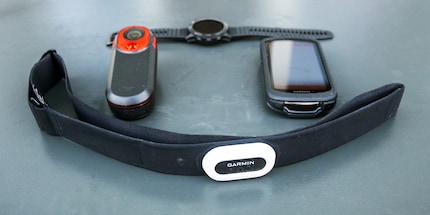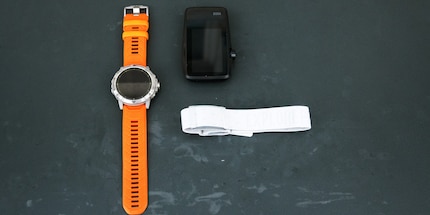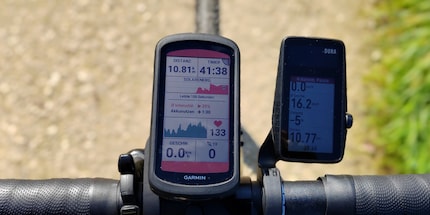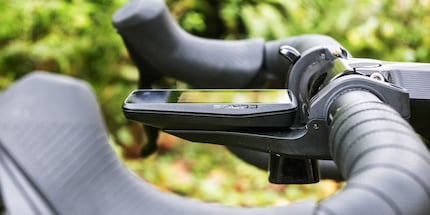
News + Trends
"Dura": The first bike computer from Coros
by Patrick Bardelli

I’ve been waiting a long time for Coros’s first bike computer. By releasing the Dura, the company’s closing a gap in its ecosystem – all while squaring up to the competition from Garmin and other manufacturers.
With the Coros Vertix 2 on my wrist and the Garmin Edge 1040 Solar on my bike, I’ve got a sports watch from one manufacturer and a bike computer from another. Garmin records all of my bike rides, while Coros keeps track of everything else. The result? Data from two separate manufacturers in two separate ecosystems.
Sure, I could choose to stick to one brand. That’s certainly what I used to do with Garmin products. In those days, everything from my sports watch to my heart rate monitor to my rear light (complete with radar) to my bike computer came from the same place. The things is, Garmin products are getting more and more expensive – the new Fenix 8 being a prime example. Depending on the version, it costs over 1,000 francs. Plus, I now have to charge my old Fenix 6 Pro at least once a week. Most likely twice a week. And that’s annoying.

When I first tested Coros sports watches a few years ago, I was particularly impressed by their battery life. Especially the Vertix 2, which holds out for up to 60 days on a full charge. It was enough for me to switch to a new watch, but I’ve stayed loyal to Garmin on the bike computer front. Until recently. In July, Coros launched the Dura, the company’s first bike computer. I reported on the product release and, in the meantime, Coros has given me one to test.
You can see the full list of specs here.

The first thing you notice about the Dura is the typical Coros dial on the right-hand side. You can use this to navigate the menu, although the device does have a built-in touchscreen too. Until now, I’ve been using the screen for menu navigation. However, now that I’m wearing my thick winter gloves more often, I control the Dura via dial. The high-resolution colour touchscreen is responsive and intuitive.
Measuring in at 99.5 × 60.8 × 15.7 mm, the Dura comes with a 2.7-inch LCD display with a resolution of 400 × 240 pixels and 64 colours. The screen’s made of composite glass, while the housing’s made of a reinforced polymer. The mount that comes included with the bike computer’s made of the same material as the housing. It’s compatible with handlebars measuring 25.4 mm or 31.8 mm. While the mount tips the scales at 53 grammes, the housing weighs 102 grammes.

Coros claims the battery lasts an impressive 120 hours in GPS mode. That’s enough juice for very long bike rides. Thanks to the Dura’s four-panel solar configuration, it apparently allows for up to two hours of additional cycling time in direct sunlight. When I tried it, the battery level had gone down by 15 per cent after 50 kilometres and roughly two and a half hours of cycling time. Mind you, that was under a thick blanket of fog, with practically no direct sunlight.
I was also using all five available satellite systems: GPS, GLONASS, Galileo, Beidou and QZSS, as well as several connected sensors. On a full charge, with no direct sunlight, the way I use the Dura results in a range of approximately 350 kilometres or 17 hours of cycling time. That’s more than enough to meet my needs.
The Dura boasts integrated global offline maps with turn-by-turn directions. New routes can be created in the Coros app or downloaded from providers such as Strava, RideWithGPS and Komoot. You can also adapt these routes while you’re out and about, search for new destinations on your phone or draw up a new route. The device synchronises the updated route in a few seconds. For me, it’s worked pretty well so far.
However, the Dura needs to be connected to a smartphone for rerouting. That works via Google’s API interface. The minor downside? You’re forced to take your phone with you on your ride.

The Dura can be connected via Bluetooth or ANT+ to numerous accessories, including performance trackers, radar devices, speed/cadence sensors, heart rate monitors and electronic gears. In my case, I’ve currently got the Vertix 2 and HRM from Coros, a rear light with radar, a cadence sensor from Garmin and electronic gears from Sram linked up to the bike computer. I don’t have any problems getting this to work either. However, it does eat into the battery.
There’s one more thing to cover before we wrap up. Coros is known for launching new products on the market before they’re 100% mature. At the same time, it’s known for delivering product updates at high speed. Since last summer, I’ve come across a few reviews criticising things like GPS accuracy and battery life. My own experience with the Dura, however, doesn’t square with that criticism. And it’s all thanks to these updates.
In launching the Dura, Coros has started to move back to its roots. You see, although the company’s now perceived as a running and outdoor brand with its watches, its first product was a smart bike helmet.
The Dura bike computer has impressed me so far. For starters, there’s its price tag. On Galaxus, the Coros model is roughly 200 francs cheaper than my previous Edge 1040 Solar. Not only that, but it’s also closed a gap in Coros’s product portfolio. All the functions I’ve tested so far have worked smoothly.
In my opinion, releasing the Dura has helped Coros on its way to becoming a real alternative to Garmin and other bike computer brands. And that can only be a good thing for us consumers. After all, competition’s good for business.
Pro
Contra
From radio journalist to product tester and storyteller, jogger to gravel bike novice and fitness enthusiast with barbells and dumbbells. I'm excited to see where the journey'll take me next.